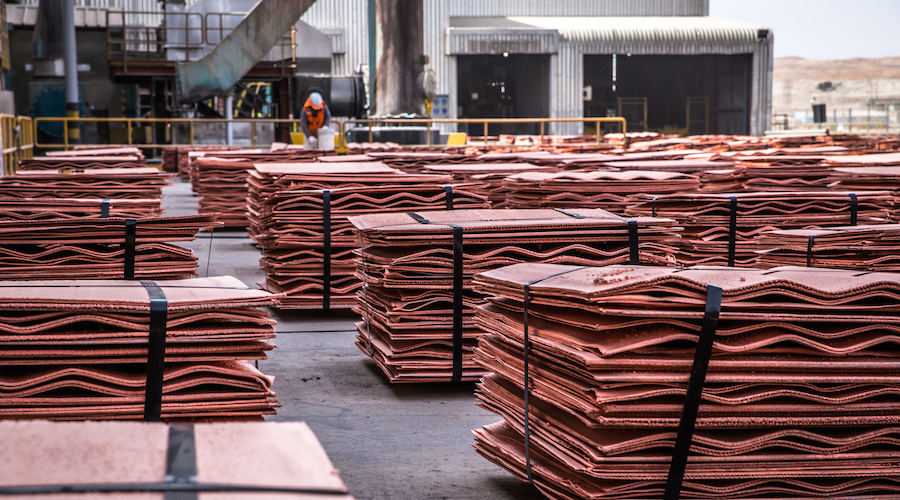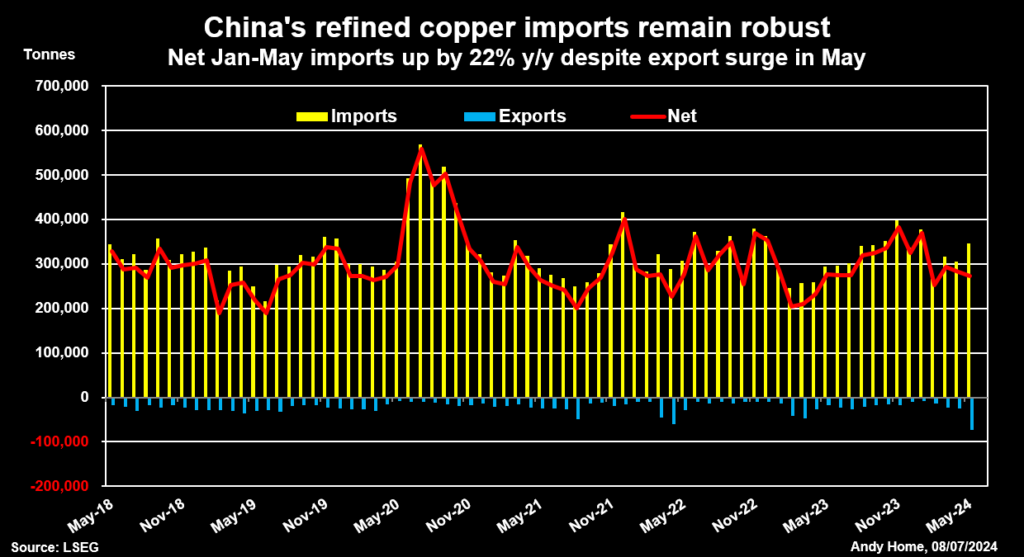Column: China’s refined copper imports remain surprisingly strong

China once again holds the key to copper’s fortunes as the market waits for the world’s largest buyer to shake off its property woes and join the bull party.
The signs are mixed to say the least.
China’s manufacturing sector contracted for the second consecutive month in June, albeit with some offset from a more positive Caixin survey, which captures smaller, export-oriented manufacturers.
Shanghai Futures Exchange (ShFE) copper stocks remain elevated at 321,642 metric tons, breaking the seasonal pattern of strong draws after the lunar new year holidays.
The Yangshan copper premium , a closely-watched indicator of China’s spot import appetite, turned negative in May and is currently zero, according to local data provider Shanghai Metal Market.
Chinese smelters, meanwhile, have been exporting copper to London Metal Exchange (LME) warehouses, driving stocks up above 190,000 metric tons for the first time since October.
Amid the negative optics, however, shines one divergent bull signal. China’s imports of refined copper have been surprisingly strong this year. Even though exports hit an eight-year high in May, outbound volumes were still dwarfed by arrivals.

African import booster
China imported 1.61 million tons of refined copper in the first five months of the year, a year-on-year increase of 19.2%.
The comparison is somewhat flattered by a low base in early 2023, when imports were relatively weak. But imports over the last 12 months have been a robust 3.98 million tons, a level exceeded only once on an annual basis in 2020.
Exports jumped to 73,860 tons in May, the highest monthly volume since May 2016, as smelters exported into a profitable arbitrage window with the London market.
Yet exports of 144,300 tons over the January-May period were still 1.7% below the same period of 2023, meaning China’s net draw on metal from the rest of the world was 262,000 tons higher.
The core driver of rising imports has been the Democratic Republic of Congo, which last year overtook Chile as China’s top supplier of refined copper.
Imports from the Congo grew from 480,000 tons in 2020 to 870,000 in 2023. Volumes so far this year have jumped by another 78% to 548,000 tons.
The accelerating trade flows between the two countries reflect fast-rising production in the Congo, which has grown to be the world’s second largest producer after Chile in 2023.
Chinese entities own and operate a large part of Congo’s copper and cobalt sector, controlling a supply chain that ends up in mainland China.
The Congo is emerging as a strategic component of China’s overall copper import strategy. As such, it remains to be seen how sensitive trade is to either price or market conditions.
Too much copper?
China’s higher imports of refined metal are being complemented by rising volumes of recyclable copper. Arrivals of 982,000 tons in the first five months of 2024 were up by 22.2% on the same period last year.
Some copper scrap is used as feed for secondary producers of refined metal and some is used as direct melt feed in the product manufacturing process. Whichever processing path taken, higher scrap imports should translate into less demand for refined metal.
Which makes this year’s strong refined metal imports all the more intriguing.
China seems awash with copper to the point that domestic smelters are comfortable shipping metal to the rest of the world.
Some of the glut is visible on the ShFE but it’s a moot point as to whether some of what has arrived has been heading to more strategic stock reserves.
The state stockpiler is looking to buy up to 15,000 tons of cobalt in expectation that prices will rise. Why not copper, given much of the world expects copper prices to hit new super-cycle highs over the coming years?
Just don’t expect any answers from the secretive National Food and Strategic Reserves Administration.
Slowdown
Everything points to a slowdown in China’s refined copper import appetite in the period ahead.
But the irony is that while the copper market has been waiting on China to confirm its bullish expectations of manufacturing recovery overlaid with green energy demand booster, China has not stopped buying copper.
This also means that if the country can escape the property drag on growth, it may not need as much imported copper as the market might expect.
Right now, China’s robust import appetite is a bull stand-out in an otherwise weak demand picture. It could equally turn into a bear indicator if and when Chinese demand does regain momentum.
(The opinions expressed here are those of the author, Andy Home, a columnist for Reuters.)
(Editing by David Evans)
{{ commodity.name }}
{{ post.title }}
{{ post.date }}

Comments